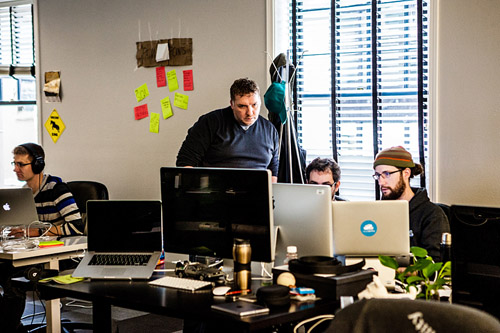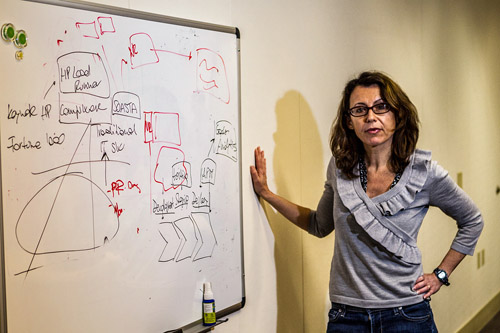 BY PETER BARNES
BY PETER BARNES
How omnipresent, seemingly limitless IT resources online will change business, culture and intelligence as we know it.
 BY PETER BARNES | PHOTOS BY JASON KAPLAN
BY PETER BARNES | PHOTOS BY JASON KAPLAN
What might a smartphone-app developer do with thousands upon thousands of high-end computers at her disposal? What about a game designer? Or a hospital? For a growing share of businesses shifting their IT off-site, the answers are limited only by their imagination.
Often visualized as clouds hovering above all who might need them, legions of remote servers provide access to computing clout once limited to the largest companies. Take Pinterest: The photo-focused social network amassed 17 million users in just nine months, all while its staff could still fit comfortably at a backyard barbecue. Not long ago, keeping up with that traffic would have required racks of expensive new servers and the manpower to configure them. Instead, Pinterest’s entrepreneurs simply plugged into data centers owned by Amazon for a monthly fee.
The online retailer is a fitting example at the other end of this quiet revolution in computing, offering anyone with a credit card access to its data centers, which have proliferated with the growth of the company. Competitors, including Microsoft and Google, followed suit, effectively turning processors and storage into a commodity as easy to draw from as the electric grid. But what truly excites experts in cloud technology like Al Kari, CEO of DetaCloud, a Camas, Wash.-based consultancy, are the implications beyond IT.
“Anything you can think of,” Kari says, invoking Google’s driverless cars and smartphones that will someday translate speakers’ languages. “All it needs is a tiny processor onboard and an ability to transmit to the cloud.”
With yearly spending growth on cloud services consistently in the double digits, Oregon’s tech companies are positioning themselves to tap that potential.
Marketers in recent years have described practically everything that connects to the Web as cloud-based, and opinions differ on where, exactly, the cloud stops and the Internet begins. Generally speaking, the concept of cloud computing describes remote access to a shared pool of servers that store information and run programs on demand.
Software as a service — one of the cloud’s most popular iterations — has been around for 15 years. Likewise, the ability to store information and run programs remotely predates even the desktop PC. What excites technologists today about the concept of cloud computing is not its newness but its maturity. An expanding buffet of services has emerged, allowing the average non-IT-savvy business owner to set up online payments, manage thousands of client accounts, or conduct memory-intensive tasks like video rendering, business analytics or even DNA sequencing.
 |
| Al Kari, CEO of DetaCloud and founder of the Portland Open Stack meetup group |
Last year business conducted in the cloud grew by 18% and totaled $131 billion, according to Connecticut-based research firm Gartner. That broad count includes Web advertising and some automated business processes that have been in use for years. Nonetheless, earnings from Amazon point to the evolution of cloud services: The business segment that contains Amazon AWS — far and away the world’s largest provider of cloud services — saw North America sales grow between 50% and 73% annually from 2010 through 2013. In just eight years since its launch, the service has become a go-to resource for new online businesses.
“The great benefit of the cloud is scaling up rapidly or scaling down rapidly,” says Damon Slye of Mad Otter Games in Eugene. “The other benefit of the cloud is that it’s easier to use if you’re not an IT expert.”
In 1984 Slye co-founded Dynamix, spinning off a cluster of game companies in Eugene that’s alive and well today. Starting Mad Otter in 2007, his team used Amazon AWS for the back-end technical services required to deliver a game from a designer’s desktop to the screens of online players. When traffic evened out over the long term, he found he could run the company’s main title, a game called Villagers and Heroes, from four high-end servers provided by a partner company in Germany at roughly one-third the cost of Amazon. In a sense, they created their own cloud accessed by players and employees, while the company can still turn to Amazon whenever it needs extra machines for load tests. That separation of IT from the day-to-day of making games lets Mad Otter’s team of six in Eugene focus on their creative endeavors.
In a quiet office with posters from Blade Runner and Seven Samurai on the walls, Slye explains another way that digital tools sold as a service have allowed companies like his to compete. Digital tool kits known as game engines let designers apply their concepts to vast repositories of existing code that defines how an animated 3-D character and its environment interact with each other. “It would be crazy to write one from scratch,” he says.
Starting in the early 2000s, companies including then-Eugene-based GarageGames began offering game engines for a monthly fee, giving independent developers access to tools that previously cost millions of dollars to license or develop on their own. That plug-and-play business model is creating efficiencies offline as well — for companies across industry sectors.
 |
| Damon Slye, co-founder of Mad Otter Games in Eugene |
Not far from Mad Otter, for example, the Eugene office of 4medica offers cloud-based services that weave together the often mismatched recordkeeping systems that medical providers access when treating patients. ”In the late ’90s, I realized that a huge problem with the whole paper chase that we were doing was the laboratory results,” says Oleg Bess, 4medica’s CEO and a practicing obstetrician and gynecologist based in Los Angeles. “Everybody in the office was always looking for that piece of paper, that test … so when the opportunity presented itself, we started a company that created this connectivity from a lab to a physician.”
Today 4medica generates about $10 million in revenue working with about 40,000 doctors, primarily helping them view and order tests from laboratories. Moving those files to 4medica’s cloud simplifies the IT on both ends and makes the test results accessible from anywhere a doctor can log in.
The company, which sells other services within the market for electronic health records, will reach $22.3 billion worldwide by the close of 2015, according to an Accenture report cited by Health Data Management magazine. In the U.S., much of that growth will be fueled by federal healthcare reforms that envision the digitization of medical records as a key way to drive down healthcare costs. That might sound straightforward, but in practice, healthcare facilities in the U.S. lack even a standardized identification number to keep track of individual patients as they visit different providers. Creating and sharing records across computer systems that weren’t designed to work together can raise a huge challenge for smaller clinics.
 |
| Mat Ellis, founder and CEO of Cloudability |
“The cloud is really an enabling technology,” says John Schmidt, 4medica’s director of interoperability, who previously helped run the Eugene office’s predecessor company, Intechgra Database Solutions. “It levels the playing field between some of the smaller practices and some of these huge, hospital-owned networks.”
In Oregon about a dozen of 4medica’s 50 employees engineer complex interfaces that connect doctors’ offices to facilities like radiology centers or a national prescription database called Surescripts. Additionally, the company and others like it employ teams of specialists to maintain their remote databases 24-seven, with a level of redundancy and security that Schmidt says would be cost prohibitive for individual clinics. “It’s hard for a practice to have that skill set onboard.”
As more databases and software find their way into the cloud, a cluster of Oregon companies has emerged to help businesses make the most of the technology. “We really are at the stage where, I think, if someone has a really great idea and can execute on it pretty well, we can see people producing tools like Instagram and WhatsApp on public cloud infrastructure with relatively minimal capital investment,” says Puppet Labs chief information officer Nigel Kersten. These massively popular products seem to appear out of nowhere, he says, because cloud services are “essentially accelerating the rate of technological change and democratizing access to computing resources.”
Puppet Labs, which Kersten left Google to join in 2011, has emerged as a leader among Oregon businesses making those resources more effective. Last year the firm more than doubled its Portland-based staff, along with its sales, as companies like Kaiser Permanente, Bank of America and REI put Puppet Labs’ software to use. Puppet Labs’ products automate tasks such as configuring new servers, implementing software updates and many other repetitive IT duties that can eat up a system administrator’s time and limit how fast a digital product can deploy. For many clients, Kersten says, it has created efficiencies that cut the timeline for launching new applications from a year or more to mere days or weeks.
 |
| Cloudability’s downtown Portland office |
That kind of automation will become increasingly critical to manage the crush of information created online every day. Cisco has forecast that global data-center traffic will triple between 2012 and 2017, when cloud applications are expected to represent two-thirds of that activity.
The ongoing migration of IT tasks to the cloud will raise its own set of challenges for managers, says Mat Ellis, founder of Portland startup Cloudability. He offers up an analogy: a vertically integrated pencil manufacturer that transitioned from ownership of graphite mines and sawmills to a company that purchases its raw materials on the open market and works with dozens of suppliers to handle everything outside the final-product assembly. As with outsourcing physical tasks, companies that turn to online businesses for IT services will have to develop new ways to integrate vendors, monitor costs and ensure quality.
“A new set of tools and processes have to bubble up, and it’s very similar to the challenges businesses had when they stopped owning every part of their supply chain,” he says. Ellis, a U.K. native, recounts how he moved to the Portland area during the recession to be closer to his wife’s family after the arrival of their second child. He started consulting to pay the bills and discovered that his large clients had only a loose grasp of where their spending for Amazon AWS and other cloud providers went. That prompted him to write a cost-tracking program that would become Cloudability, which Ellis says reveals efficiencies that frequently cut users’ cloud spending by one-fifth or more.
In the three years since Cloudability formed, the startup has grown to 27 employees, raised about $10 million in capital and now monitors nearly $1 billion in spending on behalf of its customers. That rapid expansion happened, in part, thanks to Ellis’ own use of the cloud to grow.
“It’s easier than ever to start up a company. This is my fifth one, and on the previous four we had to go spend $1 million to $2 million to get into a data center,” he says. “Now you can just plug in a credit card and pay $0.80 an hour.”
Other cloud-centered companies in Oregon include Elemental Technologies, which lets media outlets such as the BBC and ESPN process video streams in the cloud before they’re delivered to viewers. Portland also hosts most of the research and development team for San Francisco-based New Relic, which enables real-time performance monitoring and business analytics for app developers. It quadrupled the size of its office space downtown in 2012.
Meanwhile, the ranks of new cloud businesses continue to grow. Among the class of 2013 at the Wieden+Kennedy-hosted Portland Incubator Experiment, four of the seven companies — Cloneless, Orchestrate, Smart Mocha and Teak — offer cloud-based services directed at businesses. Other Portland startups in the sector attracting venture capital include Snapflow, which helps companies quickly develop Web and mobile applications, and Nouvola, which offers a testing platform for online businesses.
 |
| Paola Moretto, co-founder of Nouvola |
As the director of software for Intel’s cloud segment, Nouvola co-founder Paola Moretto became inspired by the testing needs of clients like Google and Facebook, with the latter once requesting 16,000 servers to run simulations. “Even at Intel, I don’t have 16,000 servers in my backyard to play with,” she says. Her experience corralling that volume of resources from different data centers led her to create Nouvola with a former University of California-Berkley classmate, who also came to the U.S. from Italy to pursue a career in technology in the mid-1990s.
Their creation, which won $250,000 at the Bend Venture Conference in October, can throw potentially crash-inducing levels of traffic at online businesses as they run tests in advance of real usage spikes. On an overcast Saturday in a Pearl District cafe, Moretto cast her company as a solution to just one of many similar challenges that Portland companies are stepping in to fix.
“There is a lot happening around the cloud,” she says. “Let’s make it bigger. Portland can really become a center of excellence for cloud technologies, and we have to think big.”
Recruiting skilled people, while still difficult, is much easier and more affordable in Oregon than it is in the Bay Area, says Moretto, who joined Kersten and Ellis in noting that Portland offers a desirable lifestyle that also helps entice talent. They say the presence of other cloud-focused companies has boosted the confidence of investors in recent years, while Portland’s reputation for tech collaboration is burnished by playing frequent host to the O’Reilly Open Source Convention.
In recent months, one of the fastest-growing open-source efforts among Portland programmers has formed around a cloud technology called OpenStack. The city hosted a national conference on the technology last year. And since the third quarter of 2013, a group formed by Al Kari around OpenStack has grown to include 120 people and sponsorship from companies like Suse, Puppet Labs and Jama Software. OpenStack is essentially a free operating system for server networks that NASA and Rackspace created in 2010. Since then, it has sparked a worldwide effort to create a common platform for building private and public clouds, freeing customers from the proprietary limitations of Amazon AWS and its competitors.
But for Kari, the project also represents a catalyst for disruptive technological change. The innovation and cost savings attributable to the cloud will only accelerate as service providers race to make remote computing cheaper and more prolific. The upshot for consumers, he says, will eventually be products as intuitive and interconnected as the all-knowing computer on Star Trek.
“Intelligence as a service is our ultimate goal — to actually utilize the technology the way we see in science fiction,” Kari says.
No one can say for sure when that will arrive, but Kari insists it’s not far off. After all, we already live in a world where the creator of a novel online service can test it with thousands of computers simultaneously, using little more than a laptop and the right subscription. It won’t be long before similar technology reaches outside of IT and further into everyday life, driving our cars, analyzing our medical records for unseen health risks and empowering even the simplest devices with an expanding universe of raw computing power in the cloud.


